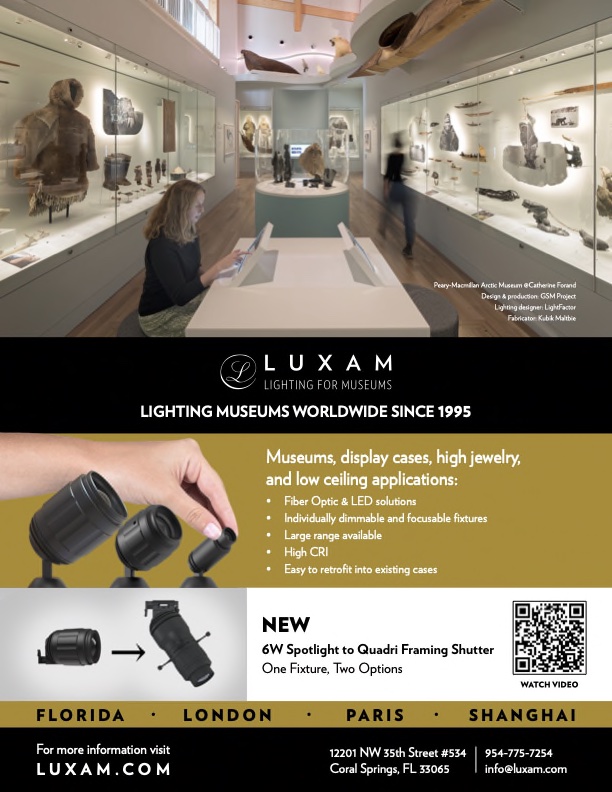
6 minute read
A Glowing Masterpiece
By Randy Reid
The new façade of the Kenneth C. Griffin Building, designed by Foster + Partners, as seen from S. Dixie Highway. Featuring Typewriter Eraser, Scale X by Claes Oldenburg and Coosje Van Bruggen.
The Norton Museum, located in West Palm Beach, FL, stands as a testament to the confluence of architecture and lighting.
George Sexton Associates was brought on board by the museum in collaboration with Foster + Partners George Sexton and Owen Brady of George Sexton Associates shed light on the careful thought that went into illuminating both the interior and exterior of this museum.
The history of the museum is quite fascinating. Originally constructed in the 1940s, the building was designed in an art deco style. However, it underwent a significant transformation in the 1990s during a period of widespread museum construction.
The museum commissioned Foster + Partners to design an addition and his approach was radical. He transformed the 1990’s addition and reorganized the spaces in a more classical manner. This process also involved renovating the original art deco building. The result was a completely new museum that maintained its historical roots while embracing modern design principles.
One of the most significant changes was the relocation of the entrance to face the Dixie Highway, one of Palm Beach’s main roads. This gave the museum a prominent presence in the community and made it a visual landmark for those entering or leaving Palm Beach.
Starting with the exterior, George emphasized the intricate balance of the lighting. The exterior of the Norton Museum is a testament to the power of subtle illumination. Rather than floodlighting the building, the design team opted for a more nuanced approach, allowing the interior of the building to glow from within and serve as a lantern. The approach was not only aesthetic but also aimed at addressing issues like light pollution, light trespass, and energy conservation. Features such as sculptures, water elements, and landscaping added layers to the external illumination. This approach endowed the museum with a distinct nighttime identity. A major highlight of the museum's architecture is the banyan tree. Owen pointed out that the building’s exterior design respected the tree, a much-loved feature, preserving its presence. The tree was illuminated using both ground-mounted uplights and tree-mounted downlights. This illuminated the internal branching structure and the canopy, creating a breathtaking visual.

The exterior of the Norton Museum is a testament to the power of subtle illumination.
The idea of capturing the building's glow from within was crucial. The walls seen through the glass facades were washed in light, their reflection captured in the metal roof canopy overhead and mirrored once more in the water feature below.
A standout feature is the Claes Oldenburg sculpture, which, with the careful use of ambient light, stands out without the need for dramatic spotlighting.
George specified B-K Lighting fixtures for the banyan tree at 3000K. An outdoor rated, ETC fixture illuminated the Oldenburg sculpture, while a linear luminaire from Acolyte wrapped around the base of the museum for site lighting.

Inside the museum, the lighting design continues to impress. The walls seen through the glass facades are washed with light, creating a reflection in the metal roof canopy overhang and in the water feature below. This creates a beautiful interplay of light and reflection that enhances the architectural features of the building.
The gallery lighting system was designed keeping flexibility in mind. With museums often rotating exhibits, the lighting system should easily adapt to the evolving displays. The design foundation was a pattern of lighting tracks in the ceiling, providing angles of light to reduce glare, and control both quantity and distribution of light.

In the realm of minimalist architecture, as exemplified by Norman Foster’s designs, lighting integration presents a significant challenge. The architecture’s discreet and highly refined nature necessitates an unobtrusive yet effective lighting solution. This hurdle was overcome through a close collaboration with LightLab, leading to the utilization of ‘Museum Line’ track and monopoint luminaires. George has a deep-rooted connection with this product, having contributed to its development with LightLab for the Museum of Modern Art, New York design many years ago. The ’Museum Line’ fixtures, an LED track system, ingeniously integrate the transformer into the track. This design innovation allows for fixtures that are not only smaller but also more discreet, seamlessly blending into the minimalist aesthetic.
One of the standout spaces inside the museum is the Shapiro Great Hall. The hall boasts concealed elliptipar® uplighting around its four sides and highlighting the complex vaulted ceiling. The lighting design was carefully executed to be invisible to the naked eye, yet impactful in its illumination. Tivoli luminaires are at the base and a skylight in the center add to the hall's allure.

Acuity’s nLight control system is used throughout the museum utilizing a variety of scenes for different occasions, from daily use to special events.
The Norton Museum stands as a glowing beacon in the heart of West Palm Beach, a fusion of historic architectural elements and cutting-edge lighting design. The collective vision of George Sexton Associates and Foster + Partners has transformed it into a radiant masterpiece that continues to captivate visitors and experts alike. It is an example of what can be achieved when thoughtful design meets innovative execution. It’s not just about illuminating a space; it’s about enhancing an architectural experience through light.

FIXTURE SCHEDULE
Controls: nLight
Downlights: Gotham, Lucifer, Portfolio, 3G Lighting
Track: Lightlab
Linear and Cove Lighting: elliptipar, Tivoli, EcoSense, PureEdge Lighting, Focal Point, Electrix Illumination
Outdoor and Site Lighting: B-K Lighting, Acolyte, Hess, Kim Lighting, WE-EF, ETC











